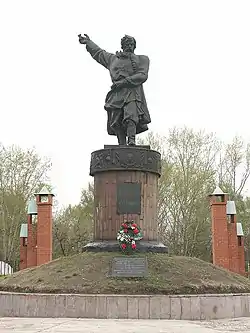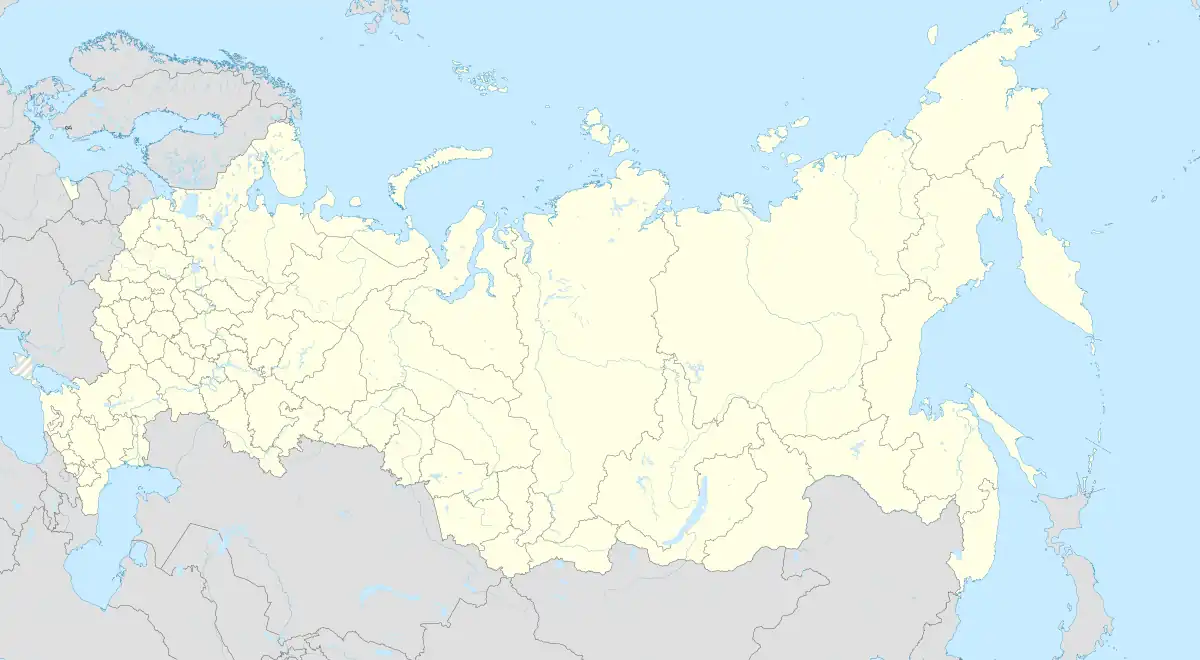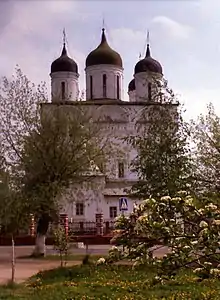Balakhna
Балахна | |
|---|---|
 | |
 Flag  Coat of arms | |
Location of Balakhna | |
 Balakhna Location of Balakhna .svg.png.webp) Balakhna Balakhna (Nizhny Novgorod Oblast) | |
| Coordinates: 56°28′N 43°36′E / 56.467°N 43.600°E | |
| Country | Russia |
| Federal subject | Nizhny Novgorod Oblast[1] |
| Administrative district | Balakhninsky District[1] |
| Town of district significance | Balakhna[1] |
| Founded | 1474 |
| Elevation | 75 m (246 ft) |
| Population | |
| • Total | 51,519 |
| • Estimate (2018)[3] | 49,126 (−4.6%) |
| • Rank | 315th in 2010 |
| • Capital of | Balakhninsky District,[1] town of district significance of Balakhna[1] |
| • Municipal district | Balakhninsky Municipal District[4] |
| • Urban settlement | Balakhna Urban Settlement[4] |
| • Capital of | Balakhninsky Municipal District,[4] Balakhna Urban Settlement[4] |
| Time zone | UTC+3 (MSK |
| Postal code(s)[6] | 606400, 606402, 606403, 606407, 606408, 606429 |
| OKTMO ID | 22505000001 |
| Website | www |
Balakhna (Russian: Балахна́) is a town and the administrative center of Balakhninsky District in Nizhny Novgorod Oblast, Russia, located on the right bank of the Volga River, 32 kilometers (20 mi) north of Nizhny Novgorod, the administrative center of the oblast. Population: 51,519 (2010 Census);[2] 57,338 (2002 Census);[7] 32,133 (1989 Census);[8] 33,500 (1968).
It was previously known as Sol-na-Gorodtse.
Overview
It was founded in 1474 as Sol-na-Gorodtse (Соль-на-Городце). After the Khan of Kazan razed it to the ground in 1536, a wooden fort was constructed to protect the settlement against further Tatar incursions. For the following three centuries, Balakhna prospered as a center of saltworks and grain trade. By the Time of Troubles, it was the twelfth largest city in Russia.
Adam Olearius visited and described the town in 1636. That year several shipwrights from Holstein built the first Russian ships here, thus establishing Balakhna as a foremost center of national river shipbuilding. The people of Balakhna were also reputed for their skills in knitting and making colored tiles, which were used for decoration of the Savior Church (1668) and other local temples. Balakhna is one of the few Russian cities shown on the 1689 Amsterdam World Map (labeled Balaghna).
The northwestern part of Balakhna is known as Pravdinsk. It used to be a separate urban-type settlement before it was merged into Balakhna in 1993. The settlement was named after the Moscow Pravda newspaper, which at some point may have been the largest consumer of newsprint produced at the local paper mill.
Administrative and municipal status
Within the framework of administrative divisions, Balakhna serves as the administrative center of Balakhninsky District.[1] As an administrative division, it is incorporated within Balakhninsky District as the town of district significance of Balakhna.[1] As a municipal division, the town of district significance of Balakhna is incorporated within Balakhninsky Municipal District as Balakhna Urban Settlement.[4]
Religion and culture
The oldest structure in the city (and in the whole region) is the tentlike church of St. Nicholas (1552). Of all the tentlike churches built in brick, this is the nearest approach to their wooden prototypes. Another church, dating from the 17th century, houses a municipal museum. The Nativity church (1675) represents an archaic monumental type of monastery cathedral. Nearby is a statue of Kuzma Minin, who was born in Balakhna.

Sport
It has a youth bandy team called FOK Olimpiyskiy.
References
Notes
- 1 2 3 4 5 6 7 8 Order #3-od
- 1 2 Russian Federal State Statistics Service (2011). Всероссийская перепись населения 2010 года. Том 1 [2010 All-Russian Population Census, vol. 1]. Всероссийская перепись населения 2010 года [2010 All-Russia Population Census] (in Russian). Federal State Statistics Service.
- ↑ "26. Численность постоянного населения Российской Федерации по муниципальным образованиям на 1 января 2018 года". Federal State Statistics Service. Retrieved January 23, 2019.
- 1 2 3 4 5 Law #107-Z
- ↑ "Об исчислении времени". Официальный интернет-портал правовой информации (in Russian). June 3, 2011. Retrieved January 19, 2019.
- ↑ Почта России. Информационно-вычислительный центр ОАСУ РПО. (Russian Post). Поиск объектов почтовой связи (Postal Objects Search) (in Russian)
- ↑ Russian Federal State Statistics Service (May 21, 2004). Численность населения России, субъектов Российской Федерации в составе федеральных округов, районов, городских поселений, сельских населённых пунктов – районных центров и сельских населённых пунктов с населением 3 тысячи и более человек [Population of Russia, Its Federal Districts, Federal Subjects, Districts, Urban Localities, Rural Localities—Administrative Centers, and Rural Localities with Population of Over 3,000] (XLS). Всероссийская перепись населения 2002 года [All-Russia Population Census of 2002] (in Russian).
- ↑ Всесоюзная перепись населения 1989 г. Численность наличного населения союзных и автономных республик, автономных областей и округов, краёв, областей, районов, городских поселений и сёл-райцентров [All Union Population Census of 1989: Present Population of Union and Autonomous Republics, Autonomous Oblasts and Okrugs, Krais, Oblasts, Districts, Urban Settlements, and Villages Serving as District Administrative Centers]. Всесоюзная перепись населения 1989 года [All-Union Population Census of 1989] (in Russian). Институт демографии Национального исследовательского университета: Высшая школа экономики [Institute of Demography at the National Research University: Higher School of Economics]. 1989 – via Demoscope Weekly.
Sources
- Государственно-правовой департамент Нижегородской области. Приказ №3-од от 27 января 2016 г. «Об утверждении реестра административно-территориальных образований, городских и сельских населённых пунктов Нижегородской области». Опубликован: "Нижегородская правда", №27(26048) (начало) и №30 (26051) (окончание), 19 и 26 марта 2016 г. (State Legal Department of Nizhny Novgorod Oblast. Order #3-od of January 27, 2016 On the Adoption of the Registry of the Administrative-Territorial Formations, Urban and Rural Localities of Nizhny Novgorod Oblast. ).
- Законодательное Собрание Нижегородской области. Закон №107-З от 28 сентября 2006 г. «Об утверждении границ, состава территории Балахнинского муниципального района и состава территорий муниципальных образований, входящих в состав Балахнинского муниципального района», в ред. Закона №13-З от 6 февраля 2013 г. «Об упразднении населённого пункта деревня Старцево в Балахнинском районе Нижегородской области и о внесении изменения в статью 1 Закона Нижегородской области "Об утверждении границ, состава территории Балахнинского муниципального района и состава территорий муниципальных образований, входящих в состав Балахнинского муниципального района"». Вступил в силу по истечении десяти дней со дня официального опубликования. Опубликован: "Нижегородские новости", №184(3596), 7 октября 2006 г. (Legislative Assembly of Nizhny Novgorod Oblast. Law #107-Z of September 28, 2006 On Establishing the Borders and the Composition of Balakhninsky Municipal District and the Composition of the Municipal Formations Within Balakhninsky Municipal District, as amended by the Law #13-Z of February 6, 2013 On Abolishing the Inhabited Locality the Village of Startsevo in Balakhninsky District of Nizhny Novgorod Oblast and on Amending Article 1 of the Law of Nizhny Novgorod Oblast "On Establishing the Borders and the Composition of Balakhninsky Municipal District and the Composition of the Municipal Formations Within Balakhninsky Municipal District". Effective as of the day after ten days from the day of the official publication have passed.).
External links
- Official website of Balakhna Archived March 4, 2011, at the Wayback Machine (in Russian)
- Directory of organizations in Balakhna (in Russian)